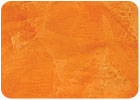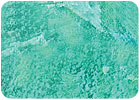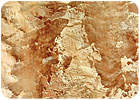
Kevin
Walsh conducts training on applying FirmoLux plaster in the Virgin Islands.

Grasso
diCalce (Red)

Marmorino
Berlina (Green)
“I have been collaborating over the past several months in forming a joint partnership to develop an educational division,” Fiocco says.
He brought in Kevin Walsh, president of Walsh Decorative Finishes to collaborate with him on the project of creating a training program that would fulfill this objective. “It is exciting for me to have someone of Kevin’s caliber, and who is passionate about his work as a master craftsman join our company. He can do incredible things with plaster that pushes the envelope,” Fiocco says.

Metallic
Plaster

This
sample of Marmorino Classic is applied with multiple colors. This technique
gives the look of a marble effect.
After his return from Europe, Walsh started working more extensively with Venetian plasters. He had been using FirmoLux’s products and upon putting them through extensive wear on applications, found that they were durable. Learning how to work with the product is one of the skills taught by the training program.
Scheduled to open in July, the training program provides techniques for applied arts and the basics for applying Venetian plaster. Another goal of the training program is to provide the practical experience necessary to work in a team.
“Learning the basics is important to the technique of applying naturals. The plaster reacts differently depending on whether you’re using a spatula or trowel,” notes Walsh.
“The trowels allow for the application/plaster to get into crevices to level it and secure the bond,” explains Fiocco. Trainees will learn these techniques and how the products can work in conjunction with one another. “It’s an art,” says Walsh. And who better to teach the fine art of Italian plastering, Walsh thought, then Carlo Mori? So upon recommendation from Walsh, Fiocco brought Mori into the United States to conduct the training courses.

Sample
application.
Training is offered to anyone with any level of experience and FirmoLux travels to the requested location. Training is also customized to the individual learner depending on what kind of experience they have. “Courses and seminars are customized according to the number of people and the purpose of the assistance requested,” says Mori.

“The student will be followed from the initial handling of the tools (trowels) until a sufficient mastering of the application procedures,” explains Mori, “both on single drywall panels first and subsequently on vertical panels to simulate the application method on walls and horizontal panels as in ceilings, if necessary.”

The
new FirmoLux building in Sarasota. The first floor will be FirmoLux’s showroom,
design studio and advanced creative training center. The upper floor will be offices.
“This is both a creative field and a trade,” says Walsh. “The beauty has created a demand for the product.” And working with this product can give contractors an increased edge, which is needed in this competitive industry. W&C

Report Abusive Comment